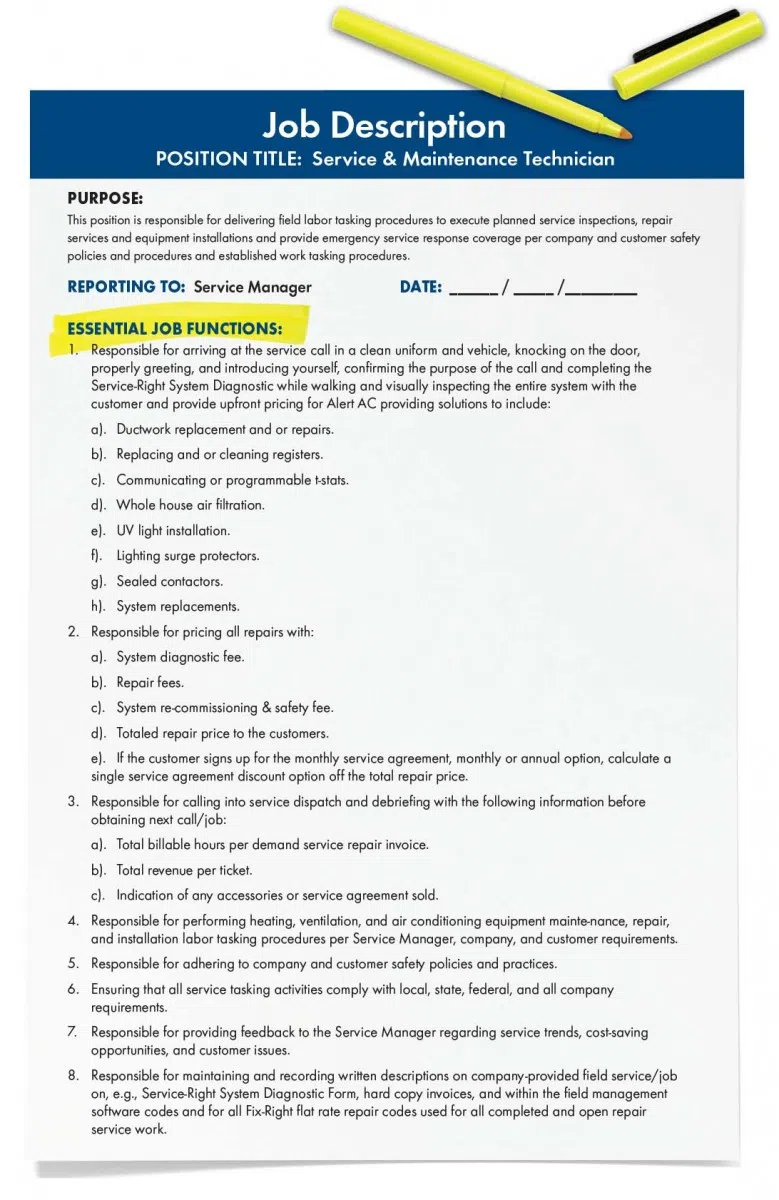The purpose and need for creating a business plan consists of a process of documenting, establishing, and implementing business direction for each of your service offerings. We o�ften refer to this e�fforts of documentation as the strategic planning process. �
The resulting plan itself becomes a management tool that provides you and your sta�ff with a step-by-step guide to better business performance and long-term success. Working with a plan will focus your e�fforts, unify your team in a single direction, and help guide you through tough business decisions. A business or strategic plan requires you to define your goals, and in defining them, enables you to achieve them, providing your company with a huge competitive advantage. In this article, we’ll illustrate seven steps for creating a thorough and effective strategic plan to lead your business toward your goals:
1. Review the past year performance.
2. Clarify your vision and mission.
3. Establish short-term goals.
4. Outline and prioritize your strategies.
5. Agree on accountability.
6. Implement Your Strategy.
7. Review and modify regularly.
STEP #1: REVIEW THE PAST YEAR PERFORMANCE.
You begin this process by checking to see if you have any or all of these 14 common business process issues/problems categories that need strategies to resolve. � The order illustrated is from greatest profit impact to least. However, all are strategic in nature to your immediate and longterm success.
1. Under-pricing as a primary closing mechanism:
• Does not properly recover technician and installer nonchargeable billable hours.
• Does not recover warranty labor and material support costs.
• Does not recover work delivery overhead costs.
2. Poor or no lead generation:
• Does not get access to residential HVAC work via AdWords campaigns through Facebook, Google, Bing, and other social media platforms.
• Does not have a residential or commercial customer-friendly website.
• Does not use onsite opportunity assessment forms to identify all service opportunities on all service and sales calls.
• Does not convert catastrophic repairs to replacements by helping consumers with the repair or replace decision.
• Does not continue to harvest all known service opportunities post call via seasonally timed direct email and text campaigns to targeted customers.
3. Lack of service brand differentiation:
• Does not create a name, symbol or design for service repairs, maintenance agreements, or replacements that is easily identifiable as belonging to the company.
• Does not use branding services to better help customers to identify them from competitor products and services.
4. Lack of value-added selling process:
• Does not use proactive selling vs. using reactionary selling.
• Does not interview customers about the system and customer needs for resolving their comfort, health, safety, property and/or � financial requirements.
5. Absence of defined operating and work delivery processes:
• Does not motivate staff� to perform at higher levels by using 100% customer satisfaction, 100% company profitability and 100% employee friendly written work delivery processes.
• Does not use work delivery standard procedures to provide sta�ff with the “How-to-do-Book” job training guides.
• Does not have the ability to reduce mobilization and human errors, missed tasking and business risk.
• Does not have the ability to eliminate call-backs via quality control start-up, test & veri�fcation forms.
6. Improper payment and liability protection terms and conditions:
• Does not use proper transaction terms and conditions in their proposals to prevent serious disruptions in cash flows and job costs overruns.
• Does not have proper proposals or invoices that adequately define scope of work, protect payment, and eliminate job risk liabilities for all work categories.
7. Lack of labor management controls:
• Does not use written step-by-step work delivery standards to enable managing people to process.
• Does not use job descriptions with clear job expectations and establish behavior with customer, company, and fellow employees.
• Does not use performance pay for management, office, and � field staff� to influence work behaviors to achieve speci�fic sales goals and for meeting or beating the budgeted labor hours on a repair ticket or on a job budgeted labor hour.
• Does not track and compare to industry typical conversion rates, each individual technician, selling tech, and/or comfort adviser, sales opportunity conversion rates for system � fixes, enhancements, accessories, or replacements.
• Does not track billable efficiency of each individual �field sta�ff member.
8. Lack of year-round labor recruiting and retention strategies:
• Does not continuously recruit to �find the best people.
• Does not have a professional looking website.
• Does not use social media like Facebook to advertise position.
• Does not create recruiting handouts and � flyers.
• Does not make sure job descriptions match position.
• Does not have a competitive benefits package.
• Does not use employee networks to recruit.
• Does not educate technicians and installers on typical repair and replacement call handling results.
• Does not train technicians on so� skill communication or does not provide scheduled manufacturers with product training or NATE certi�fication, or conduct in-house technical cross training.
9. Organizing the business for growth:
• Does not logically organize and group the office administration delivery function.
• Does not logically organize and group the sale, service, system replacement and/or construction work delivery functions.
10. Organize the customer care and dispatch function:
• Does not properly organize customer care inbound call center function.
• Does not properly organize customer data for easy access by receptionist and the dispatch function.
11. Forecasting manpower and expense budgets:
• Does not create a monthly spend plan for labor and equipment material.
• Does not identify a break-even monthly revenue to cover operating expenses, just to keep the lights on.
12. Recruiting and retaining top performers:
• Does not continuously recruit.
• Does not use upfront pricing with customer.
• Does not price in their work the ability to hire and retain the best.
• Does not use performance incentive pay for personal contributions to company pro�fitability.
• Does not use customer and/or employee friendly work delivery standards.
• Does not use job descriptions to clearly communicate employee job and work behavior expectations.
13. Lack of financial management skills and business mix tracking software:
• Does not use key performance indicators for driving per call opportunity conversions rates.
• Does not use key performance indicators for driving business revenues, cost-of-goods-sold, overhead, and net pro�fit before taxes in positive pro�fit directions.
• Does not have the ability to connect the office with � field, in order to schedule more jobs and get paid faster.
• Does not harvest post-call opportunities via obtained email or text.
• Does not allow technicians or installers to capture customer’s signature authorization to proceed with work directly on their smartphone or tablet.
• Does not auto record individual sta�ff payroll clock in/clock out for timebased payroll reports and more.
• Does not use proper customer call handling to inform when the service technician or installation crew is headed their way, so that customer is better prepared when they arrive.
• Does not integrate estimates with emails to allow sending customers estimates, job con�firmations or invoices right from the office or �field handheld and smartphones.
• Does not get business performance snapshot of total calls, inbounds,outbounds and no-answer calls.
• Does not see what channel leads came in from, why the customer called and whether it converted into a job or an estimate.
• Does not easily access customer’s contact information, establish customer’s personal communication preferences.
• Does not have the ability to obtain work updates, make deposits, send invoices, take payments automatically, and seamlessly update QuickBooks for you.
• Does not have immediate access to the customer contacts and equipment information to enable the job to be done right the first time.
14. Lack of leadership training education:
• Does not have an operating manual to properly guide management tasking functions.
• Does not use proven staff motivation techniques.
• Does not understand the four leadership characteristics.
• Does not have a continuous leadership skill self-development plan.
If you seek answers to any of these common issues, tap into an outside HVAC business expert organization like ours, or register to hear a HVAC business podcast like HVACPro™ podcast to obtain proven residential HVAC business marketing, operating processes, methodologies, governances, and associated work delivery forms within their service and replacement businesses.
STEP #2: CLARIFY YOUR VISION AND MISSION. INFUSE YOUR CULTURE.
Values should be at the core of all the decisions employees make. They show what your company stands for. Envision Your Future. When you create a clear vision, it expands the collective thinking of your organization to encompass greater possibility and influence.
Below is an example of a Vision and Mission Statement:
1. Our Commitment: We are committed to providing the highest quality and performance in all aspects of the equipment replacement industry, utilizing our core strengths to ensure the continued success of our employees and our customers.
2. Core Services: Design, fabrication, installation, and service of heating, air conditioning, indoor air quality, and ventilation systems, as well as electrical, temperature and humidity controls.
3. Core Strengths: Experienced leadership, excellence, trustworthiness, loyalty, and pride in our reputation for quality workmanship and teamwork, our multitrade capabilities, and our knowledge of and commitment to innovation.
STEP #3: ESTABLISH SHORT-TERM GOALS.
Try to align your short-term goals so they ultimately contribute to your longterm goals. These building blocks will help you immensely. Typical examples include:
• 100% customer satisfaction via proper call handling, pricing and selling standards.
• 100% employee retention via proper work delivery and safety standards,and performance incentives standards.
• 25% customer referrals via proper call handling, pricing and selling standards.
• 100% profitability and sustainability via flat rate pricing standards.
• 65%+ increase in service repair tickets via call handling standards.
• 65%+ increase in quoted system fixes and system enhancement via call handling standards.
• 85%+ service agreements with close rates to lock in your customer base via call handling and pricing standards.
• 400%+ increase in system replacements on catastrophic repairs via call handling standards.
• 1% call-backs via proper start-up, test and verification procedures.
STEP #4: OUTLINE & PRIORITIZE YOUR STRATEGIES: TYPICAL EXAMPLES INCLUDE:
1. Implement upfront � at rate pricing guides for service, system replacement and ductless minisplit installations.
2. Implement proper opportunity assessment forms on all service and sales calls.
3. Post call, continue to harvest all known opportunities by sending seasonally timed internet SEM/direct mail campaigns to targeted opportunities.
4. Implement proper terms and conditions for all transaction documents and customer provided pricing on handheld devices.
5. Implement job descriptions for all staff positions.
6. Implement written standard work delivery processes for demand service.
7. Implement written standard work delivery processes for system replacements.
8. Implement written standard work delivery processes for ductless minisplit installations.
9. Implement written standard work delivery processes for design-build services.
10. Implement performance incentive plan for management, office and field staff.
11. Implement a professional residential or commercial website presence.
12. Implement individual staff skill development training plans.
13. Restructure and organize the business for growth and by work delivery tasking functions.
14. Implement a manager self-development plan.
STEP # 5: AGREE ON ACCOUNTABILITY: SET EMPLOYEES UP FOR SUCCESS AND VERIFY ASSIGNED STAFF HAS THE CAPABILITY AND AVAILABILITY.
Make sure to discuss all of the rules and expectations at the outset. When people know what is expected of them and what their priorities are, they can work steadily toward achieving goals.
• Establish clear goals: Establishing clear goals is like getting an alignment for your car. You pull out onto the street,and your car drives beautifully. But just like at work, the road is not alwayssmooth.
• Provide immediate feedback: Your team will hit potholes and they will continually need input from their manager to stay on course.
• Enroll everyone at the organization: Our team lives the value of “hold and be held accountable.”
STEP #6: IMPLEMENT YOUR STRATEGY: REGARDLESS OF HOW VALUABLE PLANNING IS, IT IS USELESS IF YOU DON’T IMPLEMENT.
� This lack of action is undoubtedly one of the major culprits that prevent the carrying out of thoughtful planning.
This typically includes:
• De�fine metrics and success criteria for each action item.
• Set deadlines for all team members, to guarantee speedy implementation and fast turnaround of additional status information requests.
• Allocate time for the project in team members’ schedules.
• Assign ownership of specific goals and their corresponding reports to the appropriate team member.
STEP #7: REVIEW AND MODIFY REGULARLY: THE BODY THRIVES ON REGULARITY.
So do business plans. Make it a point to review regularly. Business plans should be reviewed and possibly updated at least once a year, especially for younger companies. Updating your business plan is more focused and fun than writing the original one.
• Updating your business plan regularly can help ensure that you and your partners or co-owners are on the same page.
• When major changes occur at your company or in your industry, this is also a good time to update your business plan.
• Tracking all key metrics can help you keep your � nger on the pulse of your business plan.
• Doing so can also help you monitor how well the objectives, goals,and strategies outlined in your plan are working.
• If sales are falling short of expectations, monitor your marketing plan more closely.
Wendell is CEO of GrowMyHVAC.com a division of Building Services Institute Inc. the nation’s premier online HVAC staff training and process implementation support membership organization focused on helping contractors grow and become more profitable.For additional information visit GrowMyHVAC.com.





